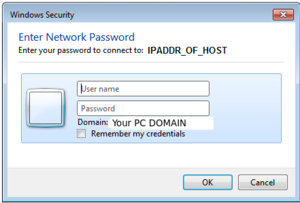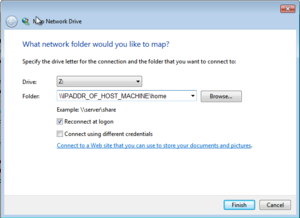OPS335 Lab 5
Contents
[hide]OBJECTIVE & PREPARATION
This lab's primary focus is to set up a Samba server on a Linux server in order to allow MS Windows users to share common files from the Linux's Samba server.
This lab will first install, setup, and enable a Samba server. Then users will access files on the Linux Samba server from Linux and Windows client machines (both graphically and command line).
INVESTIGATION 1: INSTALLING & CONFIGURING A SAMBA SERVER
In this investigation, we will set up a Samba server on our VM2 machine. We will first install, configure and enable the samba server on our virtual machine, and then we will quickly test to see if the Samba server works.
Perform the following steps:
- Make certain that both your VM1 and VM2 machines are running.
- Switch to your VM2 machine as the root user.
- Issue the following Linux command to install Samba server utlity:
yum install samba samba-client - Copy the file /etc/samba/smb.conf to another filename by issuing the following command:
cp /etc/samba/smb.conf /etc/samba/smb.conf.original - Clear the contents of the configuration file by running cat /dev/null > /etc/samba/smb.conf
- Edit /etc/samba/smb.conf so that the file that contains the following lines:
[global] workgroup = WORKGROUP server string = "put your real name here without the quotes" encrypt passwords = yes security = user passdb backend = tdbsam [home] comment = "put your real name here without the quotes" path = /home/<yourSenecaID> public = no writable = yes printable = no create mask = 0765 [homes] comment = automatic home share public = no writable = yes printable = no create mask = 0765 browseable = no
- Append (add) the following parameter to the bottom of the [global] section that will limit access to the share so that only machines in your virtual network will be able to access it:
hosts allow = 192.168.x. 127.0.0.1
- Append (add) the following parameter to the [home] section so that only your user account can access that share:
valid users = <yourSenecaID>
- Create a Samba account and password for yourSenecaID by issuing the following command:
smbpasswd -a <yourSenecaID>
- Confirm the user you created has been added using the following command:
pdbedit -L -v - Test and review your configuration with the command:
testparm - Use the systemctl command to start the smb.service and enable the service to run on boot-up
- If you have SELinux set to enforcing, you'll will need to tell it to allow samba access to home directories by running:
setsebool -P samba_enable_home_dirs 1 - Use the ss -nautp command to see with port Samba is running on.
- Use the information in the previous step to modify the firewall on VM2 machine to allow samba traffic.
- Test to see that you can connect to your Samba server (locally) by issuing the following command:
smbclient -U <yourSenecaID> -L 127.0.0.1 - When prompted, enter your Samba account password.
- The output from that issued command show appear similar to example displayed below:
Sharename Type Comment
--------- ---- -------
home Disk Your Name
IPC$ IPC IPC Service ("Your Name")
Domain=[WORKGROUP] OS=[Windows 6.1] Server=[Samba 4.2.3]
Server Comment
------ -------
WorkGroup Master
--------- ------
- To access the Samba client shell on your local Samba share, issue the following command:
smbclient '\\127.0.0.1\home' -U <yourSenecaID> - Enter your Samba account password.
- Issue the help command to note common commands (dir, cd, ls, put, get). Note how similar they are to sftp commands.
- Enter exit to terminal your local Samba session.
You can use smbclient to access, browse and share files within other Linux and Windows servers using a variety of tools which will be demonstrated in Investigations 2 and 3.
Record steps, commands, and your observations in INVESTIGATION 1 in your OPS335 lab log-book
INVESTIGATION 2: CONNECTING TO A LINUX SMB SERVER FROM A LINUX CLIENT
In this investigation you will explore some of the different ways to access a shared directory from a Linux client machine (VM1).
Installing and Using smbclient
Perform the following steps on your VM1
- Install the samba-client and cifs-utils packages.
- Use the "smbclient" command in a terminal window.
smbclient '\\vm2\home' -U <yourSenecaID>
- After entering your password you should get a prompt similar to:
smb: \>
- Enter the ls command to see a list of the files in your home directory:
smb: \> ls
- Once you have access to the directory use the get and put commands (similar to ftp) to move files.
- When you are finished close the connection.
- Try again using [homes] share instead
smbclient '\\vm2\homes' -U <yourSenecaID>Note that this tool only gave temporary access with a limited set of commands.
Using 'mount -t cifs'
Instead of always having to use the smbclient command to connect to your network share, you can have the share automatically mounted upon your file server boot-up.
Perform the following steps on your VM1
- Issue the following commands to create a mount-point and to mount your home directory from your vm2 machine:
mkdir /tmp/vm2-home mount -t cifs //vm2/home /tmp/vm2-home -o username=<yourSenecaID> ls /tmp/vm2-home
- Create a file in that directory, then switch to vm2 to confirm that it was created.
- Use umount on vm1 to unmount that directory.
Note that this tool would leave the directory mounted until the machine rebooted or it was manually unmounted. It would also allow other users access to the directory, as it effectively became part of the local filesystem. It could even be added to fstab to be mounted on boot (though this would require another configuration file we don't cover).
INVESTIGATION 3: CONNECTING TO A SAMBA SERVER FROM A WINDOWS CLIENT
This investigation will configure your VM2 machine to act as a Samba File server to allow Windows OS Users access to the Linux Samba server files.
Accessing Files on a Linux Samba Server via Windows Explorer
With some additional "tweaking" to your Linux Samba server configuration file, you should be able to access files on that file from a Windows machine on the same network. You will be creating a Samba share for your home directory of your regular user account.
Perform the following tasks:
- Make certain that your VM2 machine is running, is still allowing samba traffic through the firewall, and is still running the samba service.
- Use the Windows machine you are already running Vmware on. If you have a Linux host - good for you, you can either use a Windows VM or skip this part.
- Add the prerouting and forwarding rules to your host's iptables necessary to redirect samba traffic from outside your network to your VM2, making sure to replace the X with your own network address.
iptables -I FORWARD -p tcp --dport 139 -d 192.168.X.3 -j ACCEPTiptables -I FORWARD -p tcp --dport 445 -d 192.168.X.3 -j ACCEPTiptables -t nat -A PREROUTING -p tcp --dport 139 -j DNAT --to-destination 192.168.X.3iptables -t nat -A PREROUTING -p tcp --dport 445 -j DNAT --to-destination 192.168.X.3
OR with specifing the interface (whichever works):
iptables -t nat -A PREROUTING -i *externalinterface* -p tcp --dport 139 -j DNAT --to-destination 192.168.X.3iptables -t nat -A PREROUTING -i *externalinterface* -p tcp --dport 445 -j DNAT --to-destination 192.168.X.3
where *externalinterface* is an interface name (e.g. ens33)
NOTE: when you restart libvirtd, it will move your FORWARD rules to the end of the chain, invalidating them.
- Modify the hosts allow setting on your vm2 to also accept connections from the windows machine you are using.
- Open the Windows File Explorer application.
- At the top of the application, enter the following:
\\EXTERNAL_IPADDR_OF_HOST\home
- You will be prompted to enter your samba username and password (one time only). Refer to screenshot on right.
NOTE: It may take approximately 30 seconds to display the file contents. - Were you successful? You should have received an error stating the your credentials are incorrect. You will notice that it adds SENEDS to the beginning of your user name, as the Seneca machine is pre-configured to be part of that workgroup.
- Change the workgroup parameter in smb.conf on VM2 to match the seneca domain SENEDS, and try to connect again.
- Were you successful? If not, try to troubleshoot the problem first, then ask your lab assistant or instructor for assistance.
- Close the Windows File Explorer application window.
- Click on the START menu, and click on This PC.
- Click on the Map Network Drive button, and create a mapped network drive (called it drive Z:) which is a Samba share of your VM2 machine for the home directory.
- When finished, click on Network in Windows file manager to confirm that the network share is present.
- Try to create a file on Windows on your Linux Samba machine. Were you able to create a save a file?
- Switch to your VM2 machine and check to see if that file was created in your home directory.
Record steps, commands, and your observations from this INVESTIGATION in your OPS335 lab log-book
COMPLETING THE LAB
In completing this lab you have gained experience using a service that allows remote access to files stored on a Linux server. You have also learned how to use several different tools to access those files, both from a Linux and Windows client..
Online Submission
Follow the instructions for lab 5 on blackboard.
EXPLORATION QUESTIONS
- What does SMB stand for?
- What does CIFS stand for?
- What is the purpose of the testparm command?
- What does the text inside square brackets in the smb.conf file mean? (e.g., "[home]").
- Explain the meaning of the line "create mask = 0765" in the smb.conf file?
- What does the smbpasswd command do?

